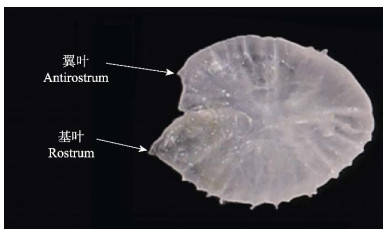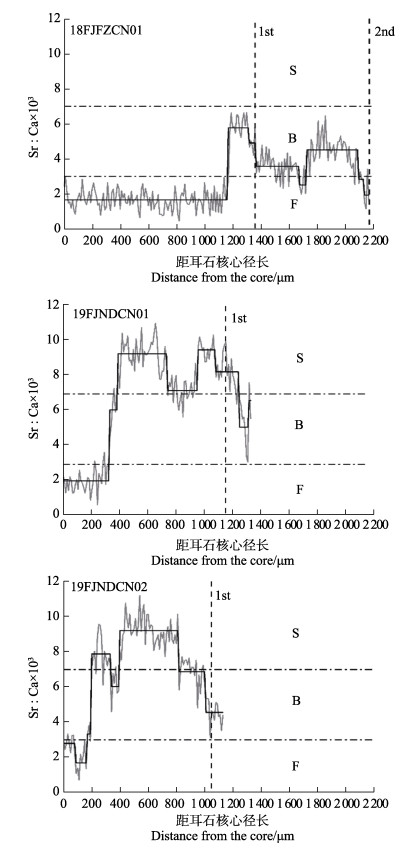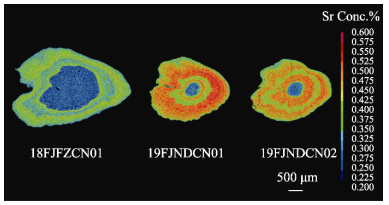2. 中国水产科学研究院淡水渔业研究中心渔业微化学实验室 江苏 无锡 214081
2. Laboratory of Fishery Microchemistry, Freshwater Fisheries Research Center, Chinese Academy of Fishery Sciences, Wuxi 214081, China
刀鲚(Coilia nasus)隶属于鲱形目(Clupeiformes)、鳀科(Engraulidae)、鲚属(Coilia),分布于西北太平洋的中国、日本和朝鲜,中国主要包括渤海、黄海、东海及入海江河(如辽河、黄河、长江等水系)中下游(成庆泰等, 1997; Hata, 2018)。已知的刀鲚主要有溯河洄游、淡水定居和淡水陆封三大生态类型,其中,溯河洄游型为溯河产卵和降海生长,而淡水定居型和淡水陆封型则是终生生活在淡水生境(倪勇等, 2006; 姜涛等, 2020)。刀鲚是我国重要的经济鱼类,由于资源量急剧下降,已于2018年被列入世界自然保护联盟(IUCN)红色名录的“濒危(EN)”等级(Hata, 2018)。我国也从2021年1月1日起,全面禁止在长江流域包括刀鲚(其禁渔于2019年2月1日开始)在内的渔业捕捞。
目前,我国刀鲚分布南界的确切位置尚不清晰。在浙江南部近15年的鱼类资源调查中发现,温州瓯江口外海域仍然是刀鲚的重要分布区域(徐兆礼, 2008; 颜文超等, 2018; 张琳琳等, 2019)。据文献记载,福建水域也有刀鲚分布,从20世纪60年代至2008年刀鲚可少量采于福鼎台山、平潭东庠、闽江新岐和马江、闽江口以及漳州东山等淡水和海水区域(王文滨, 1963; 丘书院, 1984; 林丹军等, 2009; Ma et al, 2010)。然而,仅利用常规的鱼类资源调查手段无法进一步掌握福建水域刀鲚的生态类型和生活史特征。
耳石微化学是利用鱼类的耳石具有可持续生长、代谢惰性、可作为自然生境标记材料的特点来开展研究的一种先进技术。在研究鱼类时空分布动态以及重建鱼类生境履历和洄游特征方面具有独特的优势(Campana, 2005)。矢耳石是鱼体内耳中的3对钙化耳石中最大的1对,通常首选用于解读鱼类生活史过程中所经历的栖息地环境信息(Campana, 1999)。一旦鱼类从水体环境吸收的元素沉积进耳石中,即可以作为生境的永久记录;即使仅有数尾鱼类的耳石样品,也能准确且客观地重建其生境履历(Campana, 2005; 刘洪波等, 2020)。由于海水中锶元素(Sr)含量高,而淡水中Sr含量很低,因此,耳石中Sr含量和钙(Ca)含量比值的变化可以客观有效地反演鱼类生活史中不同盐度(海水、半咸水及淡水)生境履历的转变(Campana, 1999)。迄今为止,已有多种鱼类使用此技术有效地重建了其生境履历、洄游规律和分布特征,比如鳗鲡科(Anguillidae)的日本鳗鲡(Anguilla japonica)和欧洲鳗鲡(A. anguilla),鲻科(Mugilidae)的梭状鲻(Mugil liza)、鲻(M. cephalus)和库里鲻(M. curema),鲑科(Salmonidae)的花羔红点鲑(Salvelinus malma)和银大麻哈鱼(Oncorhynchus kisutch)等(Arai et al, 2009; Fortunato et al, 2017; Umatani et al, 2018; Bae et al, 2020; Turcotte et al, 2020; Avigliano et al, 2021; Milošević et al, 2021)。
本研究利用耳石微化学技术,首次对福建水域2017—2019年间一系列鱼类资源调查中所采集到的3尾刀鲚的耳石Sr/Ca值进行检测分析,推测其生态类型、反演其生境履历以及重建其生活史。研究结果拟为进一步开展福建沿岸水域刀鲚的关键栖息地系统调查及其资源管理和保护提供理论依据和技术支撑。
1 材料与方法 1.1 刀鲚来源在2017—2019年开展的拖网、定置张网、流刺网鱼类资源调查(采样水域覆盖宁德三沙湾内外、闽江口外和闽江下游)渔获物中发现了3尾刀鲚,分别来自福建福州闽江口外海域(采样点S1:119°49'59"E,25°51'00"N)和宁德三沙湾外海域(采样点S2:119°54'04"E,26°29'10"N;采样点S3:119°49'45"E,26°29'55"N),均为海水环境(表 1)。刀鲚的鉴定依据丘书院(1984)和倪勇等(2006),主要形态特征是胸鳍上部有6根游离鳍条,呈丝状延长,伸达臀鳍基部1/3处,臀鳍鳍条数为96~97,以此区分同属的七丝鲚(C. grayii)和凤鲚(C. mystus)。对3尾刀鲚进行了基础生物学测量(表 1)。取其矢耳石,用蒸馏水和酒精清洗干净,室温干燥后再编号,置于2 mL离心管中备用。刀鲚矢耳石呈不规则的扁椭球形,与七丝鲚和凤鲚的矢耳石相比,其翼叶较发达(图 1)(郭弘艺等, 2007),进一步证实了刀鲚的鉴定准确。
|
|
表 1 福建水域3尾刀鲚标本的基本信息 Tab.1 Basic information of the three C. nasus individuals collected in Fujian waters |

|
图 1 刀鲚的右矢耳石 Fig.1 Right sagittal otolith of C. nasus |
耳石前处理和微化学分析主要参照姜涛等(2021)、Sokta等(2020)和杨一帆等(2021)的方法。统一摘取左矢耳石进行实验,使用环氧树脂先将耳石进行包埋,待固化后,切除多余的树脂,接着用AB胶将其粘在载玻片上,依次使用70 μm粒径和35 μm粒径的Discoplan-TS研磨机进行研磨,直至核心即将暴露,再用1 200目的砂纸,磨至核心暴露,最后使用LaboPol-35磨抛机将其抛光至表面无划痕。处理好的耳石样品放入Milli-Q水中超声清洗5 min后,放置37 ℃烘箱内干燥12 h。待其完全干燥后,使用JEE-420真空镀膜机镀碳膜(36 A, 25 S)。
使用碳酸钙和钛酸锶作为标准样品,对耳石中Sr、Ca含量进行量化。使用X射线电子探针微区分析仪(JXA-8100型,日本电子株式会社)分析耳石上的Sr、Ca含量,自耳石核心沿最长径至耳石边缘的一条直线进行Sr、Ca定量线分析。线分析设定的参数是加速电压15 kV,电子束电流2×10–8 A,束斑直径为5 μm,每点驻留15 s,样品点分析间隔10 μm。线分析完成后,再对耳石表面进行Sr的面分析。面分析设定的参数是加速电压15 kV,电子束电流5×10–7 A,束斑直径为5 μm,每点驻留30 ms。与Sr/Ca值线分析相比,耳石Sr含量面分析图的颜色可更直观地反映生活环境所对应的盐度,因此,结合这2种分析方法,可以更全面地评估刀鲚的生态类型。
耳石分析结束后,重新抛光并去除表面碳膜,再用5% EDTA酸蚀,最后,在Olympus BX-51多功能显微镜下读取年龄,使用Stream Start软件测量年轮沿线分析的方向距核心的距离。
1.3 数据分析在线分析中,引入分析格局变化的STARS,以便更加直观地观察刀鲚耳石Sr/Ca值的变化趋势(Rodionov et al, 2005)。STARS设定的置信度P为0.05、截断长度为5、Huber权重为1。线分析中Sr/Ca值按惯例指的是Sr/Ca×103,淡水生境中Sr/Ca值小于3,半咸水生境中Sr/Ca值介于3~7之间,海水生境中Sr/Ca值大于7 (Yang et al, 2006)。在耳石Sr强度面分布分析上,以上3种生境分别对应蓝色、绿黄色、红色图谱。
为了判断洄游性鱼类早期对淡水生境依存的程度,参考Jiang等(2014)引入淡水系数(FC)进行量化。
| $ {F_{\text{C}}} = \frac{{{L_{\text{f}}}}}{{{L_{\text{T}}}}} $ |
式中,FC代表的是早期生活史在淡水环境中的生活时间与整个生活史时间之比,Lf为线分析中从耳石核心开始连续Sr/Ca值小于3的耳石径长,LT为耳石定量线分析的总径长。
2 结果 2.1 耳石定量线分析3尾刀鲚的耳石核心区Sr/Ca值均小于3,说明它们都属于淡水产卵和淡水孵化。再根据耳石核心至边缘Sr/Ca值的不同,将其分为2种不同的生境履历模式。编号18FJFZCN01的刀鲚年龄为2龄(表 1),属于一种溯河洄游生态型(早期淡水依存型),即淡水产卵和淡水孵化,早期在淡水中生活的时间较长(第一阶段对应淡水环境径长为1 160 μm),且直到1冬龄前才进入半咸水环境,对应的淡水系数为0.53,之后在半咸水和淡水环境间活动并主要生活在半咸水环境(图 2、表 2)。编号19FJNDCN01和19FJNDCN02的刀鲚年龄都为1+龄(表 1),属于另外一种溯河洄游生态型(早期淡水适度依存型),即淡水产卵和淡水孵化,早期在淡水生活的时间较短(第一阶段对应淡水环境径长为160~330 μm),然后经过半咸水环境进入盐度较高的海水环境,对应的淡水系数为0.14~0.24,之后在海水和半咸水环境间活动并主要生活在海水环境(图 2、表 2)。

|
图 2 福建水域3尾刀鲚耳石从核心到边缘Sr/Ca值定量线的变化图 Fig.2 Fluctuation of Sr : Ca concentration ratios along line transects across the otoliths from the core to the edge of the three C. nasus individuals from Fujian waters 灰色实线表示Sr/Ca值波动值,黑色实线表示趋势转换,黑色竖虚线表示年轮(1st:1龄;2nd:2龄),黑色横虚线表示不同生境的分界(S:海水;B:半咸水;F:淡水)。 The gray solid line represents the fluctuation value of the Sr : Ca ratio, the black solid line represents the trend transition, the black vertical dashed line represents the annual rings (1st: 1-year-old; 2nd: 2-years-old), and the black horizontal dashed line represents the boundaries of different habitats (S: Seawater; B: Brackish water; F: Freshwater). |
|
|
表 2 福建水域3尾刀鲚耳石Sr和Ca微化学、生态类型及其生境模式 Tab.2 Fluctuation of Sr and Ca microchemistry in otoliths, ecological types and habitat patterns of the three individuals of C. nasus in Fujian waters |
编号18FJFZCN01的刀鲚耳石核心区域及其附近区域表现为蓝色,然后至外围边缘区域,呈现绿黄色和蓝色的交替且绿黄色居多,对应的是其早期在淡水中生活的时间较长,之后在半咸水和淡水环境间活动并主要生活在半咸水环境(图 3)。编号19FJNDCN01和19FJNDCN02的刀鲚耳石只有核心区域呈现蓝色,然后至边缘呈现绿黄色和红色的交替且红色居多,对应的是其早期在淡水生活的时间较短,之后在海水和半咸水环境间活动并主要生活在海水环境(图 3)。3尾刀鲚的Sr含量面分析结果均与线分析结果一致。

|
图 3 福建水域3尾刀鲚耳石Sr含量的面分析图谱 Fig.3 X-ray intensity maps of Sr content in the otoliths of the three C. nasus individuals in Fujian waters |
耳石中Sr、Ca元素微化学分析已经广泛应用于刀鲚生态类型的鉴定及生活史反演的研究中,涉及的水域包括我国的长江流域、黄河流域、舟山海域、黄海海域和日本的有明海海域等(Yang et al, 2006; Jiang et al, 2012、2014; 刘洪波等, 2020; 丛旭日等, 2022),但关于福建水域刀鲚耳石微化学的研究还是空白。主要原因可能是刀鲚属于暖温种,其分布主要集中在浙江以北的水域,福建水域虽然有分布但数量较少(丘书院, 1984; 田明诚等, 1993)。Ma等(2010)曾提及2007年11月在福州闽江口采集到29尾刀鲚,但对其在GenBank上传的12组序列进行重新验证分析,发现仅有2尾为刀鲚(未经耳石微化学技术确认,生态类型不明),其他样品均为七丝鲚。之后再未有涉及福建水域刀鲚的研究报道。因此,本研究是首次利用耳石微化学分析技术证实了目前福建沿岸水域仍有溯河洄游型刀鲚的分布。
值得注意的是,本研究发现福建水域所采集的刀鲚有不一样的生境履历特征。编号18FJFZCN01刀鲚的淡水系数较高,对淡水的依赖程度更大。闽江是福建省内最大的河流,其下游、河口和邻近海域有机物和营养盐十分丰富,有大量饵料生物可以满足仔鱼、幼鱼生长需要,且此处也是与刀鲚同属的凤鲚和七丝鲚的产卵场和育幼场(Xu et al, 2021),2007—2008年也曾记录有刀鲚的分布(林丹军等, 2009; Ma et al, 2010)。因此,推测这尾刀鲚的产卵场/孵化地可能在纯淡水的闽江,且在淡水水域停留时间长。而编号19FJNDCN01和19FJNDCN02刀鲚的淡水系数较低,说明早期在淡水环境中孵化和生长,但对淡水依赖的程度不高,停留时间不长,随即向高盐度海域移动,对高盐度有着较强的适应性。宁德三沙湾内有多条河流入海,较大的是北部的交溪(图 1),推测这些河流可能存在刀鲚的产卵场/孵化地。此外,鉴于刀鲚拥有长距离的游泳能力,也不排除宁德三沙湾外海域的刀鲚起源于浙江温州的瓯江或者福建福州的闽江的纯淡水水域的可能性。这些推论均有待于今后继续结合耳石其他元素和水域本底元素的研究做进一步证实(Avigliano et al, 2020)。
本研究中,3尾刀鲚耳石边缘的Sr/Ca值所对应的盐度生境比实际捕捞的区域水样的盐度要低,这是因为刀鲚对生境水盐度的响应变化存在一定的“时滞效应”,如果进入该水域生活时间不长,导致周围水体的元素还未在耳石中沉淀,造成边缘与捕捞环境无法对应,该现象在黄河流域和长江安庆江段的刀鲚研究中也有出现(李孟孟等, 2017; 丛旭日等, 2022)。
现有研究表明,中国水域的刀鲚呈现生活史类型的多样性,对不同栖息地环境有着极强的适应性,既可溯河洄游,亦可淡水定居和淡水陆封。溯河洄游型刀鲚又可以进一步划分为早期淡水依存型(早期在淡水中生活相当一段时间才进入高盐度水域)和早期淡水适度依存型(早期在淡水中生活较短时间就进入高盐度水域)(Yang et al, 2006; Jiang et al, 2012、2014; 李孟孟等, 2017; 丛旭日等, 2022)。为了更完整、有效地掌握福建沿岸水域刀鲚的分布区域及产卵场等关键栖息地位置、资源群体组成特征及洄游规律,提出有效的资源管理和保护措施,接下来有必要对福建沿海以及入海河流进行较大规模的采样调查,并对所采刀鲚的耳石样本进行Sr/Ca值及Sr含量图谱的微化学特征验证。
4 结论本研究首次利用耳石微化学分析技术证实了福建沿岸水域存在溯河洄游型刀鲚的分布。耳石Sr/Ca值以及Sr含量的图谱直观和准确地揭示了3尾刀鲚个体生态类型和生境履历的多样性特征。研究结果也合理地推测了这3尾刀鲚的产卵场/孵化地可能的水域。鉴于目前关于长江流域刀鲚的保护,已有相关“十年禁渔”、“长江保护法”等国策、法律出台,而由于对福建水域的刀鲚分布区域、产卵场位置、产卵季节以及现存资源量等尚缺乏足够的认知,需要结合新技术,加大调查和研究的力度,才有可能制定出有效的资源养护和产卵场生境保护措施。相关工作希望能得到福建沿岸海洋及渔业管理部门和相关科研机构的重视和支持。
ARAI T, CHINO N, KOTAKE A. Occurrence of estuarine and sea eels Anguilla japonica and a migrating silver eel Anguilla anguilla in the Tokyo Bay area, Japan. Fisheries Science, 2009, 75(5): 1197-1203 DOI:10.1007/s12562-009-0153-6 |
AVIGLIANO E, IBAÑEZ A, FABRÉ N, et al. Unravelling the complex habitat use of the white mullet, Mugil curema, in several coastal environments from Neotropical Pacific and Atlantic waters. Aquatic Conservation: Marine and Freshwater Ecosystems, 2021, 31(4): 789-801 DOI:10.1002/aqc.3486 |
AVIGLIANO E, IBAÑEZ A, FABRÉ N, et al. White mullet Mugil curema population structure from Mexico and Brazil revealed by otolith chemistry. Journal of Fish Biology, 2020, 97(4): 1187-1200 DOI:10.1111/jfb.14500 |
BAE S E, KIM J K. Otolith microchemistry reveals the migration patterns of the flathead grey mullet Mugil cephalus (Pisces: Mugilidae) in Korean waters. Journal of Ecology and Environment, 2020, 44: 21 DOI:10.1186/s41610-020-00164-9 |
CAMPANA S E. Chemistry and composition of fish otoliths: Pathways, mechanisms and applications. Marine Ecology Progress Series, 1999, 188: 263-297 DOI:10.3354/meps188263 |
CAMPANA S E. Otolith science entering the 21st century. Marine and Freshwater Research, 2005, 56(5): 485-495 DOI:10.1071/MF04147 |
CHEN Q T, ZHOU C W. Fishes of Shandong Province. Jinan: Shandong Science and Technology Press, 1997 [成庆泰, 周才武. 山东鱼类志. 济南: 山东科学技术出版社, 1997]
|
CONG X R, LI X Q, DONG G C, et al. Preliminary investigations on Coilia nasus from the Kenli section of the Huanghe River based on otolith microchemistry. Progress in Fishery Sciences, 2022, 43(1): 31-37 [丛旭日, 李秀启, 董贯仓, 等. 基于耳石微化学的黄河垦利段刀鲚生活史初步研究. 渔业科学进展, 2022, 43(1): 31-37] |
FORTUNATO R C, GONZÁLEZ-CASTRO M, GALÁN A R, et al. Identification of potential fish stocks and lifetime movement patterns of Mugil liza Valenciennes 1836 in the Southwestern Atlantic Ocean. Fisheries Research, 2017, 193: 164-172 DOI:10.1016/j.fishres.2017.04.005 |
GUO H Y, TANG W Q, WEI K, et al. Morphologic characters of the sagittal otoliths of the fishes of the genus Coilia from China. Chinese Journal of Zoology, 2007, 42(1): 39-47 [郭弘艺, 唐文乔, 魏凯, 等. 中国鲚属鱼类的矢耳石形态特征. 动物学杂志, 2007, 42(1): 39-47] |
HATA H. Coilia nasus. The IUCN red list of threatened species, 2018, e.T98895427A143840780
|
JIANG T, LIU H B, SHEN X Q, et al. Life history variations among different populations of Coilia nasus along the Chinese coast inferred from otolith microchemistry. Journal of the Faculty of Agriculture Kyushu University, 2014, 59(2): 383-389 DOI:10.5109/1467650 |
JIANG T, LIU H B, XUAN Z Y, et al. Classification of ecomorphotypes of Coilia nasus from the middle and lower reaches of the Yangtze River Basin. Journal of Lake Sciences, 2020, 32(2): 518-527 [姜涛, 刘洪波, 轩中亚, 等. 长江中下游流域刀鲚(Coilia nasus)生态表型的划分. 湖泊科学, 2020, 32(2): 518-527] |
JIANG T, LIU H B, XUAN Z Y, et al. Similarity of microchemical "fingerprints" between the pectoral fin ray and otolith of Coilia nasus. Progress in Fishery Sciences, 2021, 42(1): 100-107 [姜涛, 刘洪波, 轩中亚, 等. 刀鲚胸鳍条和耳石微化学"指纹"相似性研究. 渔业科学进展, 2021, 42(1): 100-107] |
JIANG T, YANG J, LIU H B, et al. Life history of Coilia nasus from the Yellow Sea inferred from otolith Sr: Ca ratios. Environmental Biology of Fishes, 2012, 95(4): 503-508 DOI:10.1007/s10641-012-0066-6 |
LI M M, JIANG T, CHEN T T, et al. Otolith microchemistry of the estuarine tapertail anchovy Coilia nasus from the Anqing section of the Yangtze River and its significance for migration ecology. Acta Ecologica Sinica, 2017, 37(8): 2788-2795 [李孟孟, 姜涛, 陈婷婷, 等. 长江安庆江段刀鲚耳石微化学及洄游生态学意义. 生态学报, 2017, 37(8): 2788-2795] |
LIN D J, YOU Y L, SU X H, et al. Fish resources in the middle and lower reaches of Min River: An investigation with analysis. Journal of Subtropical Resources and Environment, 2009, 4(4): 1-10 [林丹军, 尤永隆, 苏雪红, 等. 闽江中下游鱼类资源现状调查与分析. 亚热带资源与环境学报, 2009, 4(4): 1-10] |
LIU H B, JIANG T, XUAN Z Y, et al. Otolith microchemical analysis of tapertail anchovy Coilia nasus from Ariake Sea and its adjacent tributaries in Japan. Fisheries Science, 2020, 39(4): 500-508 [刘洪波, 姜涛, 轩中亚, 等. 日本有明海及周边水域刀鲚耳石微化学研究. 水产科学, 2020, 39(4): 500-508] |
MA C Y, CHENG Q Q, ZHANG Q Y, et al. Genetic variation of Coilia ectenes (Clupeiformes: Engraulidae) revealed by the complete cytochrome b sequences of mitochondrial DNA. Journal of Experimental Marine Biology and Ecology, 2010, 385(1/2): 14-19 |
MILOŠEVIĆ D, BIGOVIĆ M, MRDAK D, et al. Otolith morphology and microchemistry fingerprints of European eel, Anguilla anguilla (Linnaeus, 1758) stocks from the Adriatic Basin in Croatia and Montenegro. Science of the Total Environment, 2021, 786: 147478 |
NI Y, WU H L. Fishes of Jiangsu Province. Beijing: China Agriculture Press, 2006 [倪勇, 伍汉霖. 江苏鱼类志. 北京: 中国农业出版社, 2006]
|
QIU S Y. Clupeiformes: Engraulidae. In: Fishes of Fujian Province editorial subcommittee. Fishes of Fujian Province (Volume 1). Fuzhou: Fujian Science and Technology Press, 1984, 140–157 [丘书院. 鲱形目: 鳀科. 《福建鱼类志》编写组. 福建鱼类志(上卷). 福州: 福建科学技术出版社, 1984, 140–157]
|
RODIONOV S, OVERLAND J E. Application of a sequential regime shift detection method to the Bering Sea ecosystem. ICES Journal of Marine Science, 2005, 62(3): 328-332 |
SOKTA L, JIANG T, LIU H B, et al. Loss of Coilia nasus habitats in Chinese freshwater lakes: An otolith microchemistry assessment. Heliyon, 2020, 6(8): e04571 |
TIAN M C, SUN B L, YANG J M. Analysis of the fish fauna of the Bohai Sea. Studia Marina Sinica, 1993(1): 157-167 [田明诚, 孙宝龄, 杨纪明. 渤海鱼类区系分析. 海洋科学集刊, 1993(1): 157-167] |
TURCOTTE L A, SHRIMPTON J M. Assessment of spawning site fidelity in interior Fraser River Coho salmon Oncorhynchus kisutch using otolith microchemistry, in British Columbia, Canada. Journal of Fish Biology, 2020, 97(6): 1833-1841 |
UMATANI Y, ARAI T, MAEKAWA K. Flexible seaward migration of Dolly Varden Salvelinus malma in the Shiretoko Peninsula, Hokkaido, Japan. Ichthyological Research, 2018, 65(2): 202-209 |
WANG W B. Clupeiformes: Engraulidae. In: CHU Y T, ZHANG C L, CHENG Q T. Fishes of the East China Sea. Beijing: Science Press, 1963, 106–116 [王文滨. 鲱形目: 鳀科. 朱元鼎, 张春霖, 成庆泰, 主编. 东海鱼类志. 北京: 科学出版社, 1963, 106–116]
|
XU Q, JIANG Y, FANG L P, et al. Reproductive dynamics of three important Clupeiform food fishes in the Min River estuary and its adjacent nearshore waters, China. Marine and Coastal Fisheries, 2021, 13(6): 679-692 |
XU Z L. Analysis of fish diversity in the waters off the Oujiang estuary in summer and autumn. Acta Ecologica Sinica, 2008, 28(12): 5948-5956 [徐兆礼. 瓯江口海域夏秋季鱼类多样性. 生态学报, 2008, 28(12): 5948-5956] |
YAN W C, SONG W H, YU C G, et al. Studies on fish diversity and community structure in spring and autumn in Oujiang Estuary. Transactions of Oceanology and Limnology, 2018(6): 132-141 [颜文超, 宋伟华, 俞存根, 等. 瓯江口海域春秋季鱼类多样性及群落结构研究. 海洋湖沼通报, 2018(6): 132-141] |
YANG J, ARAI T, LIU H, et al. Reconstructing habitat use of Coilia mystus and Coilia ectenes of the Yangtze River estuary, and of Coilia ectenes of Taihu Lake, based on otolith strontium and calcium. Journal of Fish Biology, 2006, 69(4): 1120-1135 |
YANG Y F, JIANG T, GAO X P, et al. Discovery of anadromous Coilia nasus in the Ganjiang River, Lake Poyang Basin, China. Journal of Lake Sciences, 2021, 33(5): 1595-1606 [杨一帆, 姜涛, 高小平, 等. 赣江发现溯河洄游性刀鲚(Coilia nasus). 湖泊科学, 2021, 33(5): 1595-1606] |
ZHANG L L, JIANG R J, YIN R, et al. Spatial niche and differentiation of major nekton species in Yueqing Bay, Zhejiang, China. Chinese Journal of Applied Ecology, 2019, 30(11): 3911-3920 [张琳琳, 蒋日进, 印瑞, 等. 乐清湾主要游泳动物空间生态位及其分化. 应用生态学报, 2019, 30(11): 3911-3920] |



